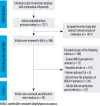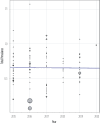Prevalence of Methicillin-resistant Staphylococcus Aureus in India: A Systematic Review and Meta-analysis
- PMID: 35949712
- PMCID: PMC9344094
- DOI: 10.5001/omj.2022.22
Prevalence of Methicillin-resistant Staphylococcus Aureus in India: A Systematic Review and Meta-analysis
Abstract
The emergence of methicillin-resistant Staphylococcus aureus (MRSA) has increased and become a serious concern worldwide, including India. Additionally, MRSA isolates are showing resistance to other chemotherapeutic agents. Isolated and valuable reports on the prevalence of MRSA are available in India. There is no systematic review on the prevalence of MRSA in one place; hence, this study was planned. The overall prevalence of MRSA in humans in India was evaluated state-wise, zone-wise, and year-wise. A systematic search from PubMed, Indian journals, Google Scholar, and J-Gate Plus was carried out and retrieved 98 eligible articles published from 2015 to 2020 in India. The statistical analysis of data was conducted using R software. The overall prevalence of MRSA was 37% (95% CI: 32-41) from 2015 to 2019. The pooled prevalence of MRSA zone-wise was 41% (95% CI: 33-50), 43% (95% CI: 20-68), 33% (95% CI: 24-43), 34% (95% CI: 26-42), 36% (95% CI: 25-47), and 40% (95% CI: 23-58) for north, east, west, south, central, and northeast region-zones, respectively. The state-wise stratified results showed a predominance of MRSA in Jammu and Kashmir with 55% (95% CI: 42-67) prevalence, and the lowest was 21% (95% CI: 11-34) in Maharashtra. The study indicated that the prevalence data would help in formulating and strict implementation of control measures in hospital areas to prevent the outbreak of MRSA infection and management of antibiotic usage.
Keywords: Antimicrobial resistance; Humans; India; Meta-analysis; Methicillin-Resistant; Prevalence; Staphylococcus aureus.
The OMJ is Published Bimonthly and Copyrighted 2022 by the OMSB.
Figures
Similar articles
-
A Systemic Literature Review and Meta-Analysis Reporting the Prevalence and Impact of Methicillin-Resistant Staphylococcus aureus Infection in India.Infect Dis (Auckl). 2020 Nov 5;13:1178633720970569. doi: 10.1177/1178633720970569. eCollection 2020. Infect Dis (Auckl). 2020. PMID: 33223835 Free PMC article.
-
Prevalence of extended-spectrum beta-lactamase producing bacteria from animal origin: A systematic review and meta-analysis report from India.PLoS One. 2019 Sep 4;14(9):e0221771. doi: 10.1371/journal.pone.0221771. eCollection 2019. PLoS One. 2019. PMID: 31483816 Free PMC article.
-
Correlation Between Biofilm Formation and Antibiotic Resistance in MRSA and MSSA Isolated from Clinical Samples in Iran: A Systematic Review and Meta-Analysis.Microb Drug Resist. 2020 Sep;26(9):1071-1080. doi: 10.1089/mdr.2020.0001. Epub 2020 Mar 10. Microb Drug Resist. 2020. PMID: 32159447
-
Methicillin-resistant Staphylococcus aureus in Nepal: A systematic review and meta-analysis.Int J Infect Dis. 2021 Feb;103:48-55. doi: 10.1016/j.ijid.2020.11.152. Epub 2020 Nov 18. Int J Infect Dis. 2021. PMID: 33217574
-
Nasal colonization of methicillin resistant Staphylococcus aureus in Ethiopia: a systematic review and meta-analysis.Ann Clin Microbiol Antimicrob. 2019 Sep 5;18(1):25. doi: 10.1186/s12941-019-0324-y. Ann Clin Microbiol Antimicrob. 2019. PMID: 31488199 Free PMC article.
Cited by
-
Prevalence of Methicillin-Resistant Staphylococcus aureus in Saudi Arabia: A Systematic Review and Meta-Analysis.Cureus. 2024 Sep 26;16(9):e70230. doi: 10.7759/cureus.70230. eCollection 2024 Sep. Cureus. 2024. PMID: 39463535 Free PMC article. Review.
-
Community-Acquired Methicillin-Resistant Staphylococcus aureus in Hospitals: Age-Specificity and Potential Zoonotic-Zooanthroponotic Transmission Dynamics.Diagnostics (Basel). 2023 Jun 16;13(12):2089. doi: 10.3390/diagnostics13122089. Diagnostics (Basel). 2023. PMID: 37370983 Free PMC article.
-
Nasal Methicillin Resistant Staphylococcus Aureus Colonisation and the Incidence of Invasive Staphylococcal Infection in Patients Undergoing Hemodialysis.Indian J Nephrol. 2025 May-Jun;35(3):419-421. doi: 10.25259/IJN_418_2024. Epub 2025 Feb 20. Indian J Nephrol. 2025. PMID: 40352893 Free PMC article. No abstract available.
-
Superbug Surge-A Tale of Seven-Year Battle Against Escalating Antimicrobial Resistance in North India.Curr Microbiol. 2025 Jun 19;82(8):340. doi: 10.1007/s00284-025-04321-y. Curr Microbiol. 2025. PMID: 40536523
-
Knowledge, Practices, and Nasal Carriage Rate of MRSA Amongst Dental Professionals.Int Dent J. 2024 Apr;74(2):199-206. doi: 10.1016/j.identj.2023.07.170. Epub 2023 Aug 21. Int Dent J. 2024. PMID: 37612155 Free PMC article.
References
-
- Sasirekha B, Usha MS, Amruta AJ, Ankit S, Brinda N, Divya R. Evaluation and comparison of different phenotypic tests to detect methicillin resistant Staphylococcus aureus and their biofilm production. Int J Pharm Tech Res 2012;4(2):532-534.
-
- Abbas A, Nirwan PS, Srivastava P. Prevalence and antibiogram of hospital acquired-methicillin resistant Staphylococcus aureus and community acquired-methicillin resistant Staphylococcus aureus at a tertiary care hospital National Institute of Medical Sciences. Communit Acquir Infect 2015;2(1):13 .10.4103/2225-6482.153857 - DOI
Publication types
LinkOut - more resources
Full Text Sources




